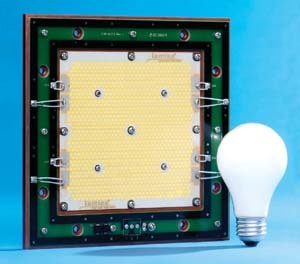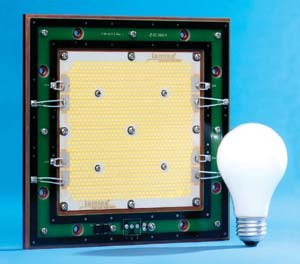The 6th annual Strategies In Light Conference, which occurred mid-February in San Francisco, focused on high-brightness (HB) LEDs. More than 340 participants heard 23 speakers, who represented market leaders within the HB-LED industry. Sponsored by Strategies Unlimited (Mountain View, CA), the conference could be considered the annual, HB-LED-marketplace, state-of-the-union summary.
Dr. Robert Steele, Strategies Unlimited’s director of optoelectronics, presented the annual HB-LED industry overview. He noted the overall 2004 HB-LED market increased from 2003’s total by 37%, to $3.7 billion.
Steele observed that, within the HB-LED marketplace, signage tied for 2nd place, with a 13% marketshare of LED use. The total 2004 HB-LED marketplace breakdown was as follows: (1) mobile applications (PDA, cell phones, cameras, etc.), 58%; (2, tie) signs, 13%; (2, tie) automotive, 13%; (4) other, 9%; (5) illumination, 5%; and (6) signals, 2%.
HB LEDs are defined by technical parameters and applications. HB LEDs are either based on InGaAlP or GaN materials. Also, standard, 5mm, l-amp packages should
produce at least several-hundred-millicandela intensities. On the application side, HB LEDs are identified by their "looks," whereby they can be easily viewed in such full-sunlight and exterior conditions as electronic billboards, traffic lights and automobile brake lights.
Steele identified sports, retail and general advertising as strong market drivers for continual HB-LED sign consumption in the future. He observed that LEDs have changed how the sign industry designs and illuminates certain signs. In less than 10 years, that influence has given the sign community a new classification of electronic signage, ranging from full-color, graphic-based, electronic message centers that advertise products and make public announcements, to high-resolution video displays that enhance billboards, sports scoreboards and spectaculars.
Advertisement
As a sign-illumination source, HB LEDs are the tip of an iceberg that contains future LED expectations. Steele noted, "The full-color sign market continued to show strength, with 20% overall growth during 2004." He said that, due to mobile applications, the HB-LED market growth will, within a few years, become saturated and will slow. However, he predicts HB LEDs’ sign-industry usage will continue to expand "with a solid growth, but at moderate rates."
A solution needs an application
Tony van de Van, chief technology architect of Lighthouse (Sciencepark, Hong Kong), gave a basic overview of LED video as an application for billboards, spectaculars and "mono-blocks," small, 3 x 6-ft., LED screens (see ST, December 2004, page 104). He also identified LED billboards as a "killer ap" for digital signage.
Jim Sloan, president of SloanLED (Ventura, CA), discussed HB-LED illumination in channel letters and architectural detailing. Highlighting existing and emerging uses of LEDs for signage, Sloan acknowledged that several LED suppliers offer competing LED channel-letter illumination formats. Although red LEDs predominate channel-letter lighting, other LED colors’ brightnesses and power efficiencies have improved. In the future, he predicted, channel-letter illumination increasingly will rely on solid-state lighting.SloanLED
A multitude of LED designs and products may confuse channel-letter fabricators and installers, Sloan warned. Installers also confront maintenance issues raised by LED-lighting products that vary from project to project. Sloan suggested that LED standardization could mitigate the problem, but poses the conundrum of which company standard to adopt



 Tip Sheet1 week ago
Tip Sheet1 week ago
 Photo Gallery3 days ago
Photo Gallery3 days ago
 Ask Signs of the Times5 days ago
Ask Signs of the Times5 days ago
 Real Deal2 weeks ago
Real Deal2 weeks ago
 Benchmarks1 week ago
Benchmarks1 week ago
 Photo Gallery8 hours ago
Photo Gallery8 hours ago
 Women in Signs2 weeks ago
Women in Signs2 weeks ago
 Women in Signs1 week ago
Women in Signs1 week ago












